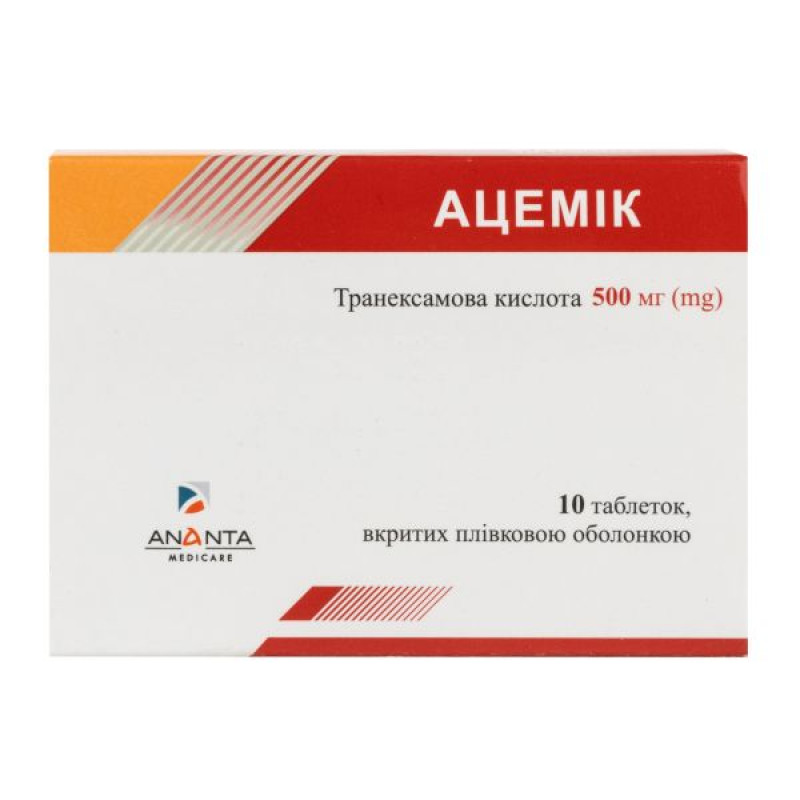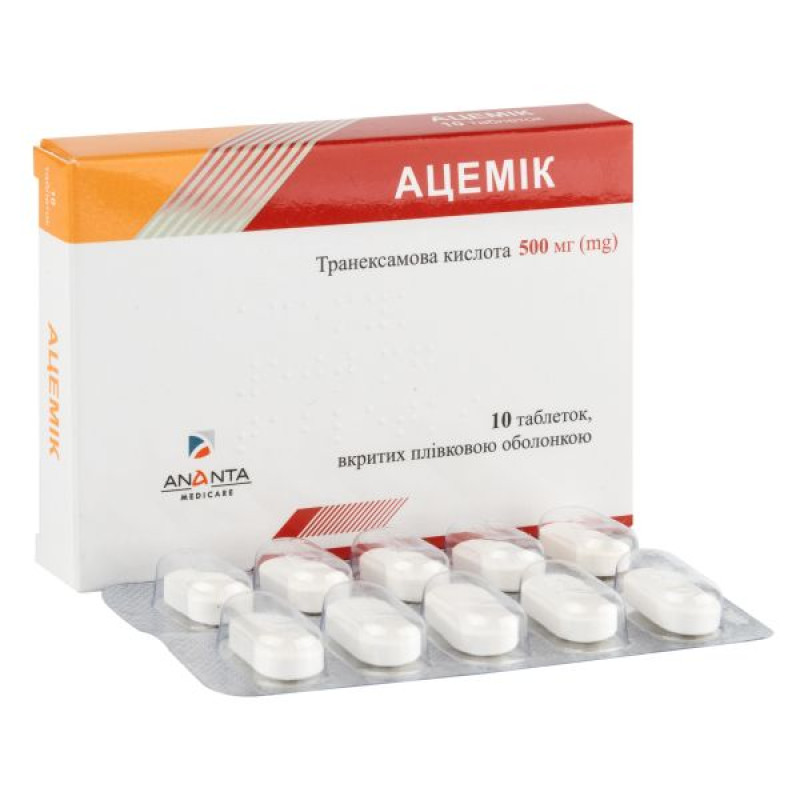Acemik film-coated tablets 500 mg blister No. 10

Instructions Acemik film-coated tablets 500 mg blister No. 10
Composition
active ingredient: tranexamic acid;
1 film-coated tablet contains tranexamic acid 500 mg;
excipients: microcrystalline cellulose, corn starch, povidone, croscarmellose sodium, stearic acid, colloidal anhydrous silicon dioxide, magnesium stearate;
tablet shell: Opadry White (hydroxypropylmethylcellulose, titanium dioxide (E 171), polyethylene glycol, polysorbate-80).
Dosage form
Film-coated tablets.
Main physicochemical properties: film-coated tablets, white or almost white, capsule-shaped, with a score on one side and embossed 500 on the other.
Pharmacotherapeutic group
Antihemorrhagic agents. Fibrinolysis inhibitors.
ATX code B02A A02.
Pharmacological properties
Pharmacodynamics
Tranexamic acid is an antifibrinolytic agent that is a potent competitive inhibitor of the activation of plasminogen to plasmin. At much higher concentrations, it is a non-competitive inhibitor of plasmin. It has been reported that the inhibitory effect of tranexamic acid on plasminogen activation by urokinase is 6-100 times greater, and by streptokinase is 6-40 times greater, than the inhibitory effect of aminocaproic acid. The antifibrinolytic effect of tranexamic acid is approximately 10 times greater than the antifibrinolytic effect of aminocaproic acid.
Pharmacokinetics
Absorption: After intravenous administration of 500 mg tranexamic acid, the maximum plasma concentration Cmax is reached immediately, then the concentration decreases within 6 hours. The half-life is about 3 hours.
Distribution: Parenterally administered tranexamic acid is distributed in two directions: delayed absorption into the cerebrospinal fluid and into cells. The volume of distribution is approximately 33% of body weight.
Tranexamic acid can penetrate the placental barrier, and in breast milk of lactating women, its concentration can reach about 1/100 Cmax.
Excretion: Tranexamic acid is excreted unchanged in the urine. 90% of the administered dose is excreted by the kidneys in the first 12 hours after administration (glomerular excretion without tubular reabsorption).
After oral administration, 1.13% and 39% of the administered dose were recovered after 3 and 24 hours, respectively.
In patients with renal insufficiency, plasma concentrations are increased.
Indication
Bleeding or risk of bleeding with increased local fibrinolysis:
menorrhagia; bleeding after prostatectomy or bladder surgery; cervical conization; nosebleeds; post-traumatic hyphema.
Hereditary angioedema.
Tooth extractions in patients with hemophilia.
Contraindication
Hypersensitivity to tranexamic acid and to the components that make up the drug, severe renal failure, macroscopic hematuria, high risk of thrombosis, thrombophlebitis, myocardial infarction, subarachnoid hemorrhage, active thromboembolic disease, history of venous or arterial thrombosis, acute venous or arterial thrombosis, fibrinolytic states after coagulopathy due to exhaustion, except for excessive activation of the fibrinolytic system in acute severe bleeding, history of seizures; impaired color perception.
Interaction with other medicinal products and other types of interactions
Tranexamic acid is incompatible with urokinase, noradrenaline bitartrate, desoxyepinephrine hydrochloride, metarmin bitartrate, dipyridamole, diazepam.
Fibrinolytic drugs
Highly active prothrombin complexes and antifibrinolytic agents, antiinhibitor coagulation complexes should not be used concomitantly with tranexamic acid.
Chlorpromazine
The combination of chlorpromazine and tranexamic acid should be avoided in patients with subarachnoid hemorrhage; this may lead to cerebral vasospasm and cerebral ischemia and possibly a decrease in cerebral blood flow.
Oral contraceptives
Tranexamic acid should be used with caution in patients using oral contraceptives, as the risk of thrombosis is increased.
Application features
In renal failure (depending on the degree of increase in serum creatinine), the dose and number of injections are reduced. In case of hematuria of renal origin (especially in hemophilia), there is a risk of mechanical anuria as a result of clot formation in the ureters. Cases of venous and arterial thrombosis or thromboembolism have been recorded in patients taking tranexamic acid. In addition, cases of occlusion of the central retinal artery and central retinal vein have been reported. Patients taking the drug for more than a few days are recommended to undergo an ophthalmological examination, including visual acuity, color vision, fundus, visual field, and assessment of liver function.
Patients with visual impairment should discontinue treatment.
Patients with a previous thromboembolic disease and a family history of thromboembolic disease (patients with thrombophilia) should use tranexamic acid only if there is a direct medical indication and under strict medical supervision.
Cases of seizures have been reported with the use of tranexamic acid, most after intravenous administration of tranexamic acid in high doses during coronary artery bypass grafting.
Tranexamic acid should not be taken concomitantly with factor IX complex or anti-inhibitor coagulation complexes, as the risk of thrombosis may be increased.
The use of tranexamic acid in cases of increased fibrinolysis due to disseminated intravascular coagulation is not recommended.
Tranexamic acid was detected in semen at fibrinolytic concentrations but did not affect sperm motility. Clinical studies have shown no effect on fertility.
Patients with irregular menstrual bleeding should not use tranexamic acid until the cause of the bleeding is determined. If tranexamic acid does not reduce the intensity of menstrual bleeding, alternative treatment should be considered.
There is no clinical experience with the use of tranexamic acid for the treatment of menorrhagia in children under 15 years of age.
Ability to influence reaction speed when driving vehicles or other mechanisms
While using the drug, you should refrain from driving and working with complex mechanisms.
Use during pregnancy or breastfeeding
Tranexamic acid crosses the placenta and into breast milk. Safety studies of the drug during pregnancy have not been conducted, so during this period the drug can be prescribed only when the expected benefit to the pregnant woman outweighs the potential risk to the fetus. If necessary, the drug should be discontinued.
Method of administration and doses
Adults are prescribed the drug orally. It is used regardless of food intake. The tablets are swallowed whole, washed down with water. The tablets should not be chewed or crushed.
Local fibrinolysis: the recommended dose is 15-25 mg/kg of body weight, i.e. 2-3 tablets of 500 mg 2-3 times a day.
Prostatectomy: for the prevention and treatment of hemorrhages in patients at increased risk before or after surgery, tranexamic acid is prescribed as an injection, after which it is prescribed as tablets of 1 g (2 tablets of 500 mg) 3-4 times a day until the disappearance of macroscopic hematuria.
Menorrhagia: the recommended dose is 2 tablets of 500 mg 3 times a day, for no more than 4 days. In case of prolonged menstrual bleeding, the dose is increased, without exceeding the maximum dose (8 tablets of 500 mg per day). It is not necessary to start treatment with the drug before the onset of menstrual bleeding.
Nosebleeds: for periodic bleeding, 2 tablets of 500 mg are prescribed 3 times a day for 7 days.
Cervical conization: 3 tablets of 500 mg 3 times a day are prescribed.
Post-traumatic hyphema: 2-3 tablets of 500 mg 3 times a day. The dose is 25 mg/kg 3 times a day.
Tooth extraction in patients with hemophilia: The recommended dose is 25 mg/kg of tranexamic acid orally every 8 hours, starting 1 day before surgery and continuing for 2-8 days after surgery.
Hereditary angioedema: Some patients who are aware of the course of exacerbations of the disease usually need 2-3 tablets of 500 mg 2-3 times a day for several days. Other patients should take the drug at the same dose for a long time, depending on the course of the disease.
Impaired renal excretory function: dose adjustment is necessary for patients with mild to moderate renal insufficiency.
Children: Administer to children at a dose of 25 mg/kg. Data on the efficacy, dosage, and safety of tranexamic acid in children are limited.
Elderly patients: in the absence of impaired renal excretory function, dose adjustment is not required.
Patients with renal insufficiency: the dose should be adjusted according to the plasma creatinine level.
| Plasma creatinine, μmol/L | Dosage |
| 120-249 | 15 mg/kg 2 times a day |
| 250-500 | 15 mg/kg once daily |
Children
There is no clinical experience with the use of tranexamic acid in children under 15 years of age with menorrhagia, therefore the drug should not be used in this category of patients.
Overdose
Symptoms: nausea, vomiting, abdominal pain, orthostatic hypotension, hypotension, dizziness, headache, seizures or increased manifestations of other adverse reactions, including the risk of thrombosis.
Treatment: induce vomiting, gastric lavage, take activated charcoal. It is necessary to consume a large amount of fluid to promote renal excretion. Symptomatic treatment is used and, if necessary, anticoagulant therapy.
Adverse reactions
On the part of the digestive tract: nausea, vomiting, heartburn, diarrhea, abdominal pain, decreased appetite.
Skin and subcutaneous tissue disorders: rash, itching, urticaria, allergic skin reactions.
On the part of the organs of vision: color perception disorders, visual impairment, congestive retinopathy, retinal vein/artery occlusion.
Immune system disorders: hypersensitivity reactions, including anaphylaxis.
Vascular disorders: thrombosis of any location, thromboembolism, arterial hypotension.
Renal: acute renal cortical necrosis.
Expiration date
2 years.
Storage conditions
Store in the original packaging at a temperature not exceeding 25 °C.
Keep out of reach of children.
Packaging
10 tablets in a blister. 1 blister in a box.
Vacation category
According to the recipe.
Producer
Tulip Lab Pvt. Ltd.
Location of the manufacturer and its business address
F-20/21, Ranjangaon MIDC, Tal. Shirur, Dist. Pune, India.
There are no reviews for this product.
There are no reviews for this product, be the first to leave your review.
No questions about this product, be the first and ask your question.








